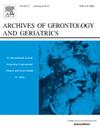Respiratory symptoms in preserved ratio impaired spirometry: Link to comorbidities and increased mortality risk
IF 3.8
3区 医学
Q2 GERIATRICS & GERONTOLOGY
引用次数: 0
Abstract
Backgroundx
Respiratory symptoms are frequently observed in subjects with Preserved Ratio Impaired Spirometry (PRISm); however, their association with comorbidities and mortality in this population remains poorly understood.
Methods
Data from the National Health and Nutrition Examination Survey (2007–2012) were analyzed. Logistic regression was used to assess the association between respiratory symptoms and comorbidities, while Cox regression was applied to evaluate mortality risks.
Results
This study included 5612 adults aged 40 years and older with normal spirometry and 754 participants with PRISm. Among the PRISm group, 331 subjects (43.8 %) reported one or more respiratory symptoms. Compared to individuals with normal spirometry, PRISm subjects with respiratory symptoms exhibited a significantly higher prevalence of comorbidities, including hypertension, diabetes, angina, myocardial infarction, heart failure, and stroke, as well as increased risks of all-cause and cardiovascular mortality. In contrast, PRISm without respiratory symptoms was primarily associated with diabetes and an elevated mortality risk. When comparing PRISm subjects with and without respiratory symptoms, those with symptoms had a markedly higher prevalence of hypertension (OR 1.10, 95 % CI: 1.08–1.11), myocardial infarction (OR 5.75, 95 % CI: 2.25–14.67), heart failure (OR 5.52, 95 % CI: 2.50–12.19), and cancer (OR 2.34, 95 % CI: 1.12–4.86). Additionally, PRISm subjects with respiratory symptoms faced a significantly elevated risk of cardiovascular mortality (HR 1.55, 95 % CI: 1.38–1.74).
Conclusions
Respiratory symptoms were associated with a significantly higher burden of comorbidities and an increased risk of cardiovascular mortality in PRISm subjects.
保留比例肺量受损患者的呼吸症状:与合并症和死亡风险增加有关
背景:保留比肺功能受损(PRISm)患者经常观察到呼吸道症状;然而,在这一人群中,它们与合并症和死亡率的关系仍然知之甚少。方法对2007-2012年全国健康与营养检查调查资料进行分析。采用Logistic回归评估呼吸道症状与合并症之间的关系,采用Cox回归评估死亡风险。结果本研究纳入肺功能正常的40岁及以上成人5612人,PRISm患者754人。在PRISm组中,331名受试者(43.8%)报告了一种或多种呼吸道症状。与肺活量测定正常的个体相比,出现呼吸系统症状的PRISm受试者的合并症患病率明显更高,包括高血压、糖尿病、心绞痛、心肌梗死、心力衰竭和中风,以及全因死亡率和心血管死亡率的风险增加。相比之下,没有呼吸道症状的PRISm主要与糖尿病和死亡风险升高相关。当比较有和没有呼吸系统症状的PRISm受试者时,有症状者的高血压(OR 1.10, 95% CI: 1.08-1.11)、心肌梗死(OR 5.75, 95% CI: 2.25-14.67)、心力衰竭(OR 5.52, 95% CI: 2.50-12.19)和癌症(OR 2.34, 95% CI: 1.12-4.86)的患病率明显更高。此外,有呼吸道症状的PRISm受试者面临心血管死亡风险显著升高(HR 1.55, 95% CI: 1.38-1.74)。结论:在PRISm受试者中,呼吸道症状与更高的合并症负担和心血管死亡风险增加相关。
本文章由计算机程序翻译,如有差异,请以英文原文为准。
求助全文
约1分钟内获得全文
求助全文
来源期刊
CiteScore
7.30
自引率
5.00%
发文量
198
审稿时长
16 days
期刊介绍:
Archives of Gerontology and Geriatrics provides a medium for the publication of papers from the fields of experimental gerontology and clinical and social geriatrics. The principal aim of the journal is to facilitate the exchange of information between specialists in these three fields of gerontological research. Experimental papers dealing with the basic mechanisms of aging at molecular, cellular, tissue or organ levels will be published.
Clinical papers will be accepted if they provide sufficiently new information or are of fundamental importance for the knowledge of human aging. Purely descriptive clinical papers will be accepted only if the results permit further interpretation. Papers dealing with anti-aging pharmacological preparations in humans are welcome. Papers on the social aspects of geriatrics will be accepted if they are of general interest regarding the epidemiology of aging and the efficiency and working methods of the social organizations for the health care of the elderly.

 求助内容:
求助内容: 应助结果提醒方式:
应助结果提醒方式:


